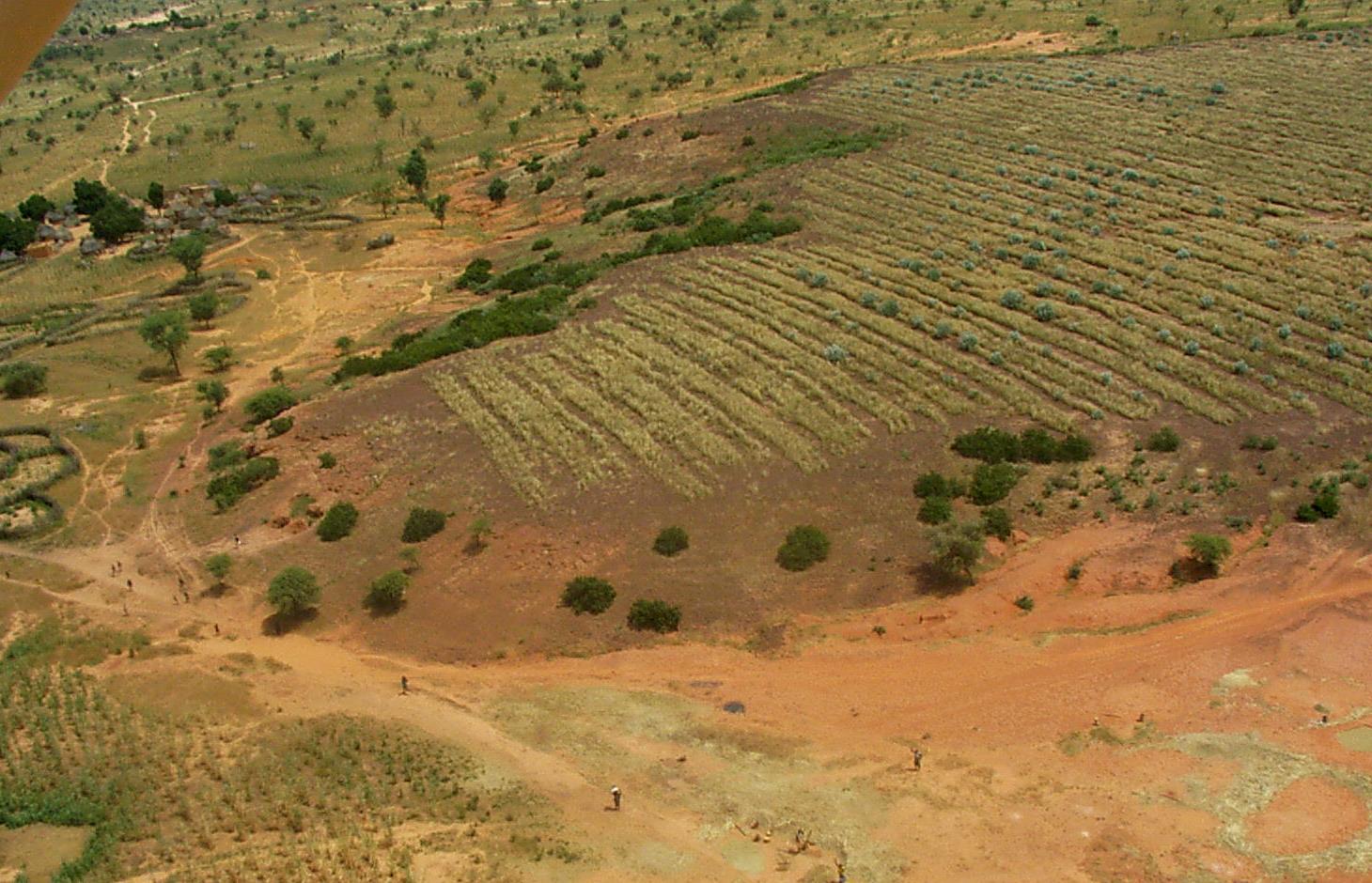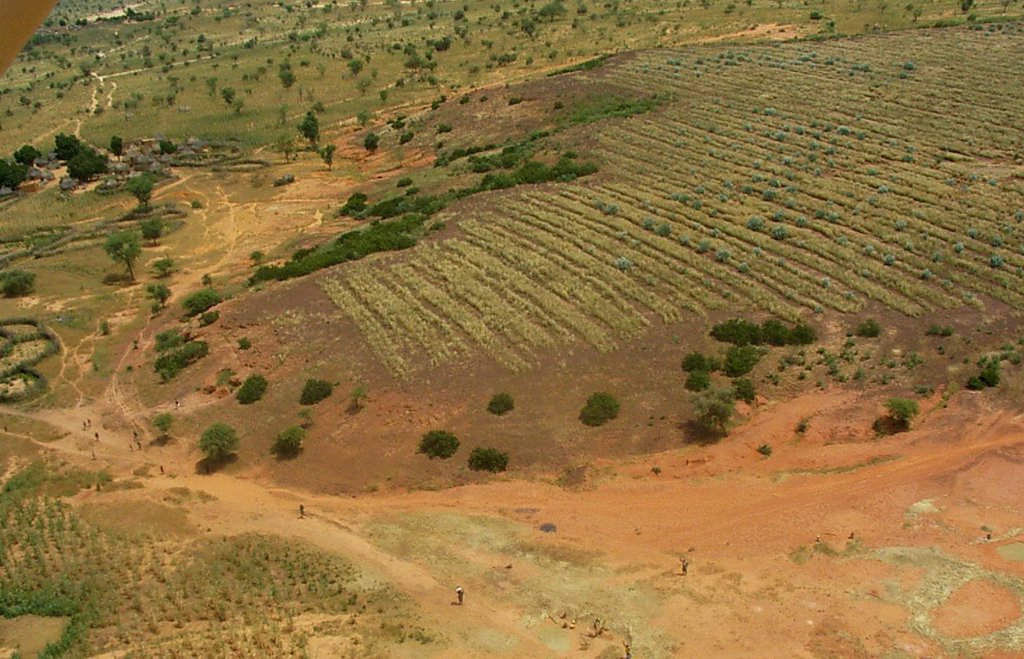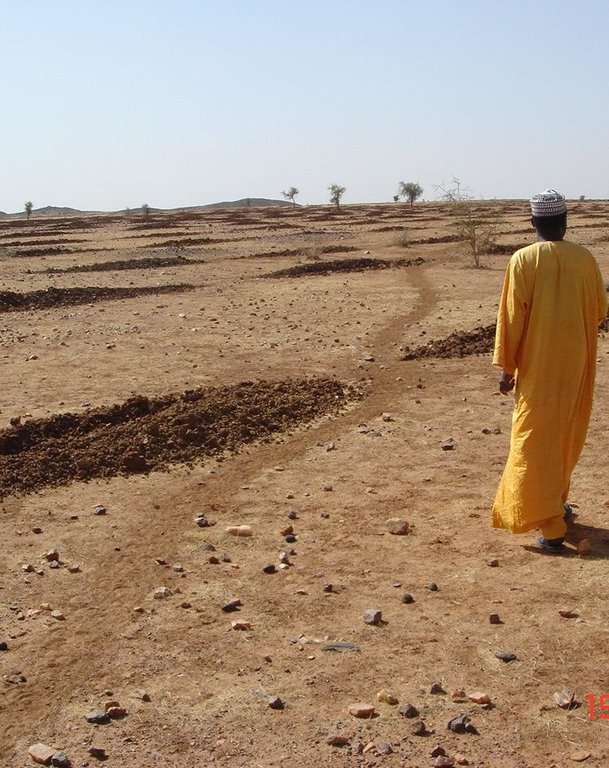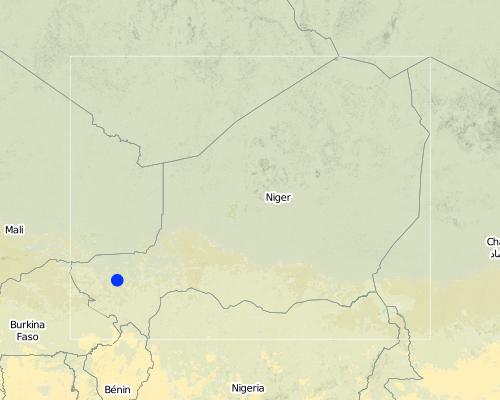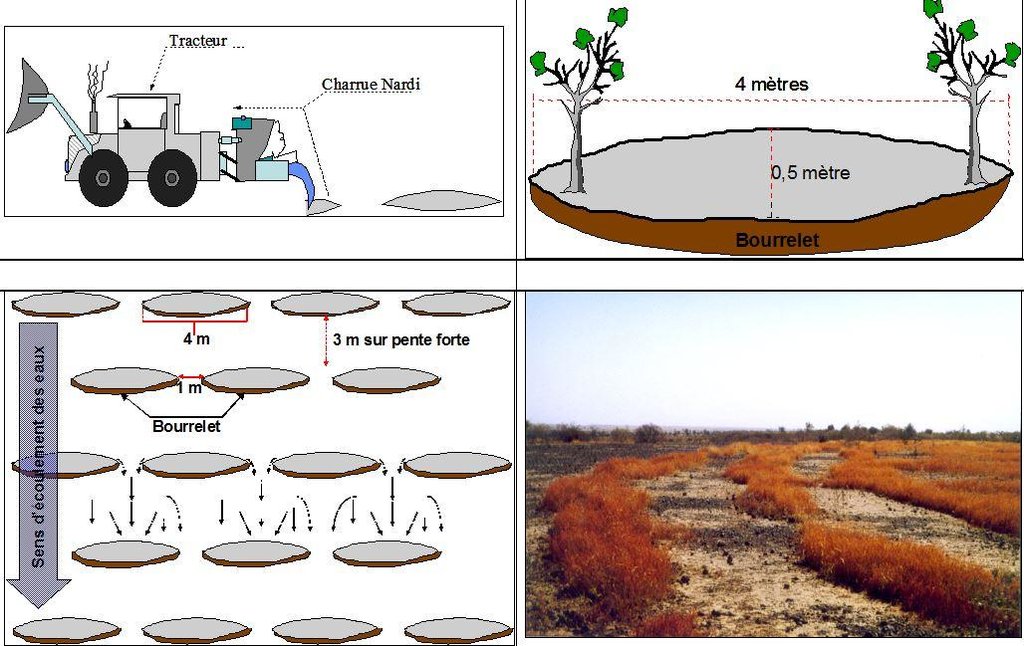Nardi/Vallerani trenches [尼日尔 ]
- 创建:
- 更新:
- 编制者: Dieter Nill
- 编辑者: –
- 审查者: Deborah Niggli
Tranchées Nardi (French)
technologies_1613 - 尼日尔
查看章节
全部展开 全部收起1. 一般信息
1.2 参与该技术评估和文件编制的资源人员和机构的联系方式
有助于对技术进行记录/评估的项目名称(如相关)
Good Practices in Soil and Water Conservation - A contribution to adaptation and farmers ́ resilience towards climate change in the Sahel (GIZ)有助于对技术进行记录/评估的机构名称(如相关)
Deutsche Gesellschaft für Internationale Zusammenarbeit (GIZ) GmbH (GIZ) - 德国1.3 关于使用通过WOCAT记录的数据的条件
(现场)数据是什么时候汇编的?:
01/07/2012
编制者和关键资源人员接受有关使用通过WOCAT记录数据的条件。:
是
1.4 所述技术的可持续性声明
这里所描述的技术在土地退化方面是否存在问题,导致无法被认为是一种可持续的土地管理技术?:
否
2. SLM技术的说明
2.1 技术简介
技术定义:
Nardi/Vallerani trenches are microcatchments which are made using a special tractor-pulled plough to restore degraded and encrusted forests and rangelands
2.2 技术的详细说明
说明:
Nardi/Vallerani trenches are microcatchments 4 m long and 0.5 m wide. They are made using a tractor-pulled plough specifically designed for this purpose. The Nardi plough cuts a furrow perpendicular to the slope, throwing up a ridge on the downhill side and thereby creating a barrier on that side of the furrow. The number of trenches varies according to the gradient of the terrain and the type of soil: the recommended number of microcatchments for flat or gently sloping terrain is between 250 and 400 per hectare, with the rows spaced 5 to 7 m apart; and for steeper slopes, the rows should be spaced 3 to 4 m apart, with a density of up to 600 microcatchments per hectare. In each Nardi/Vallerani microcatchment, two or three trees are planted or sown by direct seeding and then separated when they come up. Perennial grasses are sown a year later to allow the trees to become established first. The choice of species largely depends on the use to which the improved land is to be put and the priorities of the beneficiaries. It is recommended that the improved site be protected from grazing animals for at least three years to give the trees time to grow and the grass time to reproduce naturally, although the exact amount of time required will depend on the type of trees planted and how degraded the site is.
Nardi/Vallerani trenches are generally combined with scarification, which is carried out using a tractor-pulled scarifier. The strips between the trenches are scarified a year after they have been dug. These scarified strips are sown with perennial grasses at the same time as the trenches. The trees planted the year before are a year old, and the risk of the saplings being choked by the grass is minimal.
Runoff collects in the Vallerani microcatchments, improving the infiltration of water into the soil and the retention of water for the plants growing in them. They also serve to loosen the soil and improve the plants’ access to nutrients. Windborne seeds are trapped in the microcatchments, which helps to build up the natural grass cover.
This technique is particularly effective when rainfall is low, as the microcatchments retain water and make it available to the plants growing in them.
In the medium term, this technique is effective in protecting the land against water and wind erosion and rehabilitating barren land with no vegetation. In wet years, the microcatchments protect the land downhill from excessive run- off by retaining part of the water.
Implemented on a wide scale, this technique can extend and improve the quality of forest and rangeland and reduce the problems for livestock keepers in years when the quality of pasture is not good. In the medium and long- term, the technique can increase the supply of firewood, timber and other wood products. Even in the short term, it increases the production of straw, which can be used as forage, for making roofing and mats or sold to generate extra income.
Establishment / maintenance activities and inputs: In order to ensure the sustainability of the investment, it is necessary to take the following steps before constructing the trenches: ensure that the communities are motivated to invest in the measure; ensure that the communities have the capacity to do the work and the technical expertise required to implement the measures and develop and manage the sites; ensure that there are sufficiently strong local and regional markets for forest/rangeland products; clearly define the objective (intended uses after improvement); clarify ownership of the land to be improved; jointly define who the beneficiaries will be; formulate an agreement establishing rules governing the protection, use and upkeep of the site.
The right grass species must be chosen to ensure the successful establishment of vegetation cover, taking the following factors into consideration: needs of livestock keepers and/or agro-pastoralists; species suited to environmental conditions, taking into account climate changes; palatability and nutritive value of the species and any secondary uses they may have; availability of seeds; potential for marketing products.
The Sahel is a region where the population has always faced a high degree of climate variability, manifested both in terms of time (unexpected dry spells can occur during the rainy season) and in terms of space (rainfall can vary greatly from one area to another). The population is mainly composed of small farmers and livestock keepers.
Over the last two decades, the effects of climate change have exacerbated the already difficult conditions. Accord¬ing to projections made by climatologists, the Sahel will experience a rise in temperatures combined with highly variable rainfall and an increase in extreme weather events.
The Soil and Water conservation and rehabilitation techniques have helped people in the Sahel to manage their ecosystems more effectively and improve their productive land. As a result, communities are better prepared to cope with environmental changes (changes in the climate, land degradation, etc.) and the im¬pact of shocks, particularly droughts
2.3 技术照片
2.5 已应用该技术的、本评估所涵盖的国家/地区/地点
国家:
尼日尔
区域/州/省:
Niger
有关地点的进一步说明:
Regions of Tillabéri, Filingué, Ouallam, Téra and Tahuoa
Map
×2.6 实施日期
如果不知道确切的年份,请说明大概的日期:
- 10-50年前
2.7 技术介绍
详细说明该技术是如何引入的:
- 通过项目/外部干预
注释(项目类型等):
developed, implemented and disseminated as part of projects and programmes undertaken from the 1980s onwards to combat desertification and improve natural resource management. Implemented by GIZ (German Federal Enterprise for International Cooperation), PDRT (Projet de développement rural de Tahoua - Tahoua Rural Development Project), PASP (Projet de protection intégrée des ressources agro-sylvo-pastorales Tillabéri-Nord - Project for the Integrated Protection of Agricultural, Forest and Rangeland Resources in Tillabéri-Nord)
3. SLM技术的分类
3.1 该技术的主要目的
- 减少、预防、恢复土地退化
3.2 应用该技术的当前土地利用类型

牧场
粗放式放牧场:
- 半游牧/游牧
集约放牧/饲料生产:
- 收割和携带/零放牧

森林/林地
(半天然)天然森林/林地:
- 选伐
产品和服务:
- 木材
- 薪材
- 水果和坚果
- 其它森林产品
- 放牧/啃牧
注释:
Major land use problems (compiler’s opinion): crusting, surface runoff, water and wind erosion, unadapted land use methods, rapidly growing population increasing pressure on land, reduced or abandoned fallow periods, insecure access to land.
Farmers are mainly agropastoralists with some communities specialised on pure pastoralism
Constraints of forested government-owned land or commons
3.3 有关土地利用的更多信息
该技术所应用土地的供水:
- 混合雨水灌溉
每年的生长季节数:
- 1
具体说明:
Longest growing period in days: 120, Longest growing period from month to month: August to October
牲畜密度(如相关):
1-10 LU /km2
3.4 该技术所属的SLM组
- 改良的地面/植被覆盖
- 最小的土壤扰动
- 横坡措施
3.6 包含该技术的可持续土地管理措施

植物措施
- V1:乔木和灌木覆盖层
- V2:草和多年生草本植物

结构措施
- S4:平沟、坑
3.7 该技术强调的主要土地退化类型

土壤水蚀
- Wt:表土流失/地表侵蚀
- Wo:场外劣化效应

土壤风蚀
- Et:表土流失

化学性土壤退化
- Cn:肥力下降和有机质含量下降(非侵蚀所致)

物理性土壤退化
- Pc:压实
- Pk:熟化和结壳

生物性退化
- Bc:植被覆盖的减少

水质恶化
- Ha:干旱化
注释:
Main causes of degradation: soil management (Unadapted land use methods, reduced or abandoned fallow periods), crop management (annual, perennial, tree/shrub) (Neglect of fallow periods and crop rotation), droughts (due to heat waves), population pressure (rapidly growing population increasing pressure on land), land tenure (insecure access to land and collectively managaed commons), poverty / wealth (very poor population)
Secondary causes of degradation: deforestation / removal of natural vegetation (incl. forest fires) (deforestation through overgrazing and fire wood collection), over-exploitation of vegetation for domestic use (firewood collection), overgrazing (cattle, shee and goats), change in temperature (Climate change: heat waves), change of seasonal rainfall (more variable onset of rain), Heavy / extreme rainfall (intensity/amounts) (more variable and intensive rains), wind storms / dust storms (frequent storms), floods (due to intensive rains), labour availability (some migration of men to nearby cities), education, access to knowledge and support services (high level of illiteracy)
3.8 防止、减少或恢复土地退化
具体数量名该技术与土地退化有关的目标:
- 减少土地退化
- 修复/恢复严重退化的土地
4. 技术规范、实施活动、投入和成本
4.1 该技术的技术图纸
4.2 技术规范/技术图纸说明
Nardi/Vallerani trenches are microcatchments 4 m long and 0.5 m wide. The Nardi plough cuts a furrow perpendicular to the slope, throwing up a ridge on the downhill side and thereby creating a barrier on that side of the furrow. The recommended number of microcatchments for flat or gently sloping terrain is between 250 and 400 per hectare, with the rows spaced 5 to 7 m apart; and for steeper slopes, the rows should be spaced 3 to 4 m apart, with a density of up to 600 microcatchments per hectare.
Source of drawing: Ministère du Développement Agricole Niger (without date): Recueil des fiches techniques en gestion des ressources naturelles et de productions agro-sylvo-pastorales.
Location: Niger
Technical knowledge required for field staff / advisors: high
Technical knowledge required for land users: moderate
Main technical functions: control of dispersed runoff: retain / trap, control of dispersed runoff: impede / retard, control of concentrated runoff: retain / trap, control of concentrated runoff: impede / retard, improvement of ground cover, improvement of surface structure (crusting, sealing), improvement of topsoil structure (compaction), increase of infiltration, increase / maintain water stored in soil, water harvesting / increase water supply
Secondary technical functions: stabilisation of soil (eg by tree roots against land slides), increase in nutrient availability (supply, recycling,…), sediment retention / trapping, sediment harvesting, reduction in wind speed, promotion of vegetation species and varieties (quality, eg palatable fodder)
Vegetative measure: within each microcatchment 2-3 trees
Vegetative material: T : trees / shrubs, G : grass
Number of plants per (ha): 700-1250
Vegetative measure: Vegetative material: T : trees / shrubs, G : grass
Retention/infiltration ditch/pit, sediment/sand trap
Spacing between structures (m): 5-7
Depth of ditches/pits/dams (m): 0.4
Width of ditches/pits/dams (m): 0.5
Length of ditches/pits/dams (m): 4
Vegetation is used for stabilisation of structures.
4.3 有关投入和成本计算的一般信息
其它/国家货币(具体说明):
CFA Franc
注明美元与当地货币的汇率(如相关):1美元=:
521.18
4.4 技术建立活动
| 活动 | 措施类型 | 时间 | |
|---|---|---|---|
| 1. | The Nardi plough cuts a furrow perpendicular to the slope, throwing up a ridge on the downhill side and thereby creating a barrier on that side of the furrow | 结构性的 | |
| 2. | In each Nardi/Vallerani microcatchment, two or three trees are planted or sown by direct seeding | 植物性的 |
4.5 技术建立所需要的费用和投入
| 对投入进行具体说明 | 单位 | 数量 | 单位成本 | 每项投入的总成本 | 土地使用者承担的成本% | |
|---|---|---|---|---|---|---|
| 劳动力 | labour | ha | 1.0 | 16.3 | 16.3 | 100.0 |
| 设备 | machine use | ha | 1.0 | 23.6 | 23.6 | 100.0 |
| 设备 | transport and planting trees | ha | 1.0 | 12.3 | 12.3 | 100.0 |
| 植物材料 | seedlings | ha | 1.0 | 52.0 | 52.0 | 100.0 |
| 技术建立所需总成本 | 104.2 | |||||
4.6 维护/经常性活动
| 活动 | 措施类型 | 时间/频率 | |
|---|---|---|---|
| 1. | Separating trees when they come up | 植物性的 | |
| 2. | Perennial grasses are sown a year after the trees to allow the trees to become established first. | 植物性的 | |
| 3. | The strips between the trenches are scarifieda year after they have been dug. These scarified strips are sown with perennial grasses at the same time as the trenches. | 植物性的 |
4.7 维护/经常性活动所需要的费用和投入(每年)
注释:
Microcatchments on low-gradient terrain
• 1 Nardi plough (imported from Italy)
• tractor hire.
Labour
• 8.5 man-days per ha.
Other costs
• 800 seedlings and 15 kg of seeds (plus transport and replacement plants).
4.8 影响成本的最重要因素
描述影响成本的最决定性因素:
The slope determines the costs. The number of trenches varies according to the gradient of the terrain and the type of soil: the recommended number of microcatchments for flat or gently sloping terrain is between 250 and 400 per hectare, with the rows spaced 5 to 7 m apart; and for steeper slopes, the rows should be spaced 3 to 4 m apart, with a density of up to 600 microcatchments per hectare.
5. 自然和人文环境
5.1 气候
年降雨量
- < 250毫米
- 251-500毫米
- 501-750毫米
- 751-1,000毫米
- 1,001-1,500毫米
- 1,501-2,000毫米
- 2,001-3,000毫米
- 3,001-4,000毫米
- > 4,000毫米
农业气候带
- 半干旱
Thermal climate class: subtropics
5.2 地形
平均坡度:
- 水平(0-2%)
- 缓降(3-5%)
- 平缓(6-10%)
- 滚坡(11-15%)
- 崎岖(16-30%)
- 陡峭(31-60%)
- 非常陡峭(>60%)
地形:
- 高原/平原
- 山脊
- 山坡
- 山地斜坡
- 麓坡
- 谷底
垂直分布带:
- 0-100 m a.s.l.
- 101-500 m a.s.l.
- 501-1,000 m a.s.l.
- 1,001-1,500 m a.s.l.
- 1,501-2,000 m a.s.l.
- 2,001-2,500 m a.s.l.
- 2,501-3,000 m a.s.l.
- 3,001-4,000 m a.s.l.
- > 4,000 m a.s.l.
5.3 土壤
平均土层深度:
- 非常浅(0-20厘米)
- 浅(21-50厘米)
- 中等深度(51-80厘米)
- 深(81-120厘米)
- 非常深(> 120厘米)
土壤质地(表土):
- 中粒(壤土、粉土)
- 细粒/重质(粘土)
表土有机质:
- 中(1-3%)
5.4 水资源可用性和质量
地下水位表:
5-50米
地表水的可用性:
中等
水质(未处理):
仅供农业使用(灌溉)
5.5 生物多样性
物种多样性:
- 低
5.6 应用该技术的土地使用者的特征
生产系统的市场定位:
- 生计(自给)
- 混合(生计/商业
非农收入:
- 收入的10-50%
相对财富水平:
- 非常贫瘠
- 贫瘠
机械化水平:
- 手工作业
- 畜力牵引
性别:
- 男人
说明土地使用者的其他有关特征:
Population density: 10-50 persons/km2
Annual population growth: 3% - 4% (mostly poor households below poverty line).
Off-farm income specification: men migrate temporarily or permanently to cities for off-farm income, women and men seasonally carry out paid farm work
5.7 应用该技术的土地使用者拥有或租用的平均土地面积
- < 0.5 公顷
- 0.5-1 公顷
- 1-2 公顷
- 2-5公顷
- 5-15公顷
- 15-50公顷
- 50-100公顷
- 100-500公顷
- 500-1,000公顷
- 1,000-10,000公顷
- > 10,000公顷
这被认为是小规模、中规模还是大规模的(参照当地实际情况)?:
- 小规模的
5.8 土地所有权、土地使用权和水使用权
土地所有权:
- 州
- 社区/村庄
土地使用权:
- 自由进入(无组织)
- 社区(有组织)
用水权:
- 自由进入(无组织)
- 社区(有组织)
注释:
traditional land use rights prevail. On fields individual land use rights, communal land on pasture and forest land (collection of wood and other products (fruits, medicinal plants))
5.9 进入服务和基础设施的通道
健康:
- 贫瘠
- 适度的
- 好
教育:
- 贫瘠
- 适度的
- 好
技术援助:
- 贫瘠
- 适度的
- 好
就业(例如非农):
- 贫瘠
- 适度的
- 好
市场:
- 贫瘠
- 适度的
- 好
能源:
- 贫瘠
- 适度的
- 好
道路和交通:
- 贫瘠
- 适度的
- 好
饮用水和卫生设施:
- 贫瘠
- 适度的
- 好
金融服务:
- 贫瘠
- 适度的
- 好
6. 影响和结论性说明
6.1 该技术的现场影响
社会经济效应
生产
饲料生产
饲料质量
畜牧生产
注释/具体说明:
It is recommended that the improved site be protected from grazing animals for at least three years to give the trees time to grow and the grass time to reproduce naturally
木材生产
生产区域
收入和成本
农业收入
其它社会经济效应
amount of straw (used as forage or sold and/or used for roofing, doors and fencing)
社会文化影响
食品安全/自给自足
冲突缓解
contribution to human well-being
注释/具体说明:
Implemented on a wide scale, this technique can extend and improve the quality of forest and rangeland and reduce the problems for livestock keepers in years when the quality of pasture is not good. In the medium and long-term, the technique can increase the supply of firewood, timber and other wood products. Even in the short term, this technique increases the production of straw, which can be used as forage, for making roofing and mats or sold to generate extra income. The forest/rangeland sites help communities to bridge the hunger gap, and in lean years, the women collect forest products, such as leaves, pods and fruit to supplement their diet. Sometimes, small quantities of wood are sold to buy cereals. Ingredients for medicinal products and other secondary products, such as gum arabic, are collected from the trees and bushes.
生态影响
水循环/径流
水的回收/收集
地表径流
土壤
土壤水分
土壤覆盖层
土壤流失
土壤结壳/密封
土壤压实
养分循环/补给
生物多样性:植被、动物
生物量/地上C
SLM之前的数量:
100 kg/ha
SLM之后的数量:
540 kg/ha
植物多样性
减少气候和灾害风险
风速
6.2 该技术的场外影响已经显现
下游洪水
风力搬运沉积物
6.3 技术对渐变气候以及与气候相关的极端情况/灾害的暴露和敏感性(土地使用者认为的极端情况/灾害)
渐变气候
渐变气候
| 季节 | 气候变化/极端天气的类型 | 该技术是如何应对的? | |
|---|---|---|---|
| 年温度 | 增加 | 好 |
气候有关的极端情况(灾害)
气象灾害
| 该技术是如何应对的? | |
|---|---|
| 局地暴雨 | 不好 |
| 局地风暴 | 好 |
气候灾害
| 该技术是如何应对的? | |
|---|---|
| 干旱 | 好 |
水文灾害
| 该技术是如何应对的? | |
|---|---|
| 比较和缓的(河道)洪水 | 不好 |
注释:
Physical structures can be biologically stabilized through planting of grass, bushes or trees. Damages are generally small but need to be repaired quickly.
6.4 成本效益分析
技术收益与技术建立成本相比如何(从土地使用者的角度看)?
短期回报:
积极
长期回报:
非常积极
技术收益与技术维护成本/经常性成本相比如何(从土地使用者的角度看)?
短期回报:
积极
长期回报:
非常积极
注释:
In the short term, this technique increases the production of straw, which can be used as forage, for making roofing and mats or sold to generate extra income. In the medium and long-term, the technique can increase the supply of firewood, timber and other wood products.
6.5 技术采用
注释:
The techniques were implemented with food for work in the 1990s to 2000. At the end, the work provided by land users was not compensated. Only small equipment and transportation were provided for free. Some adoption (without support by the project) has been observed in some places.
There is a little trend towards spontaneous adoption of the Technology. Some adoption (without support by the project) has been observed in some places.
6.7 该技术的优点/长处/机会
| 编制者或其他关键资源人员认为的长处/优势/机会 |
|---|
| In the medium term, this technique is effective in protecting the land against water and wind erosion and rehabilitating barren land with no vegetation. |
| Runoff collects in the Vallerani microcatchments, improving the infiltration of water into the soil and the retention of water for the plants growing in them. They also serve to loosen the soil and improve the plants’ access to nutrients. Windborne seeds are trapped in the microcatchments, which helps to build up the natural grass cover. |
| In wet years, the micro-catchments protect the land downhill from excessive runoff by retaining part of the water. |
| This technique is particularly effective when rainfall is low, as the microcatchments retain water and make it available to the plants growing within them. |
| The average additional output of dry matter in the form of herbaceous biomass was approximately 540 kg/ha, compared with less than 100 kg per hectare on land where the technique was not applied |
6.8 技术的弱点/缺点/风险及其克服方法
| 编制者或其他关键资源人员认为的弱点/缺点/风险 | 如何克服它们? |
|---|---|
| Animal production is reduced because the improved site should be protected from grazing animals for at least three years to give the trees time to grow and the grass time to reproduce naturally | |
| Vallerani microcatchments are recommended for use on well-structured soils (soils with high clay content and lateritic and stony soils). On poorly structured soils (sandy, silty soils), the furrows tend to close over after the first rains, rendering them ineffective. | |
| The Acacia holosericea species is not considered suitable for reforestation purposes, owing to its limited life span. |
7. 参考和链接
7.1 信息的方法/来源
- 实地考察、实地调查
- 与土地使用者的访谈
7.2 参考可用出版物
标题、作者、年份、ISBN:
Good Practices in Soil and Water Conservation. A contribution to adaptation and farmers´ resilience towards climate change in the Sahel. Published by GIZ in 2012.
可以从哪里获得?成本如何?
http://agriwaterpedia.info/wiki/Main_Page
链接和模块
全部展开 全部收起链接
无链接
模块
无模块


